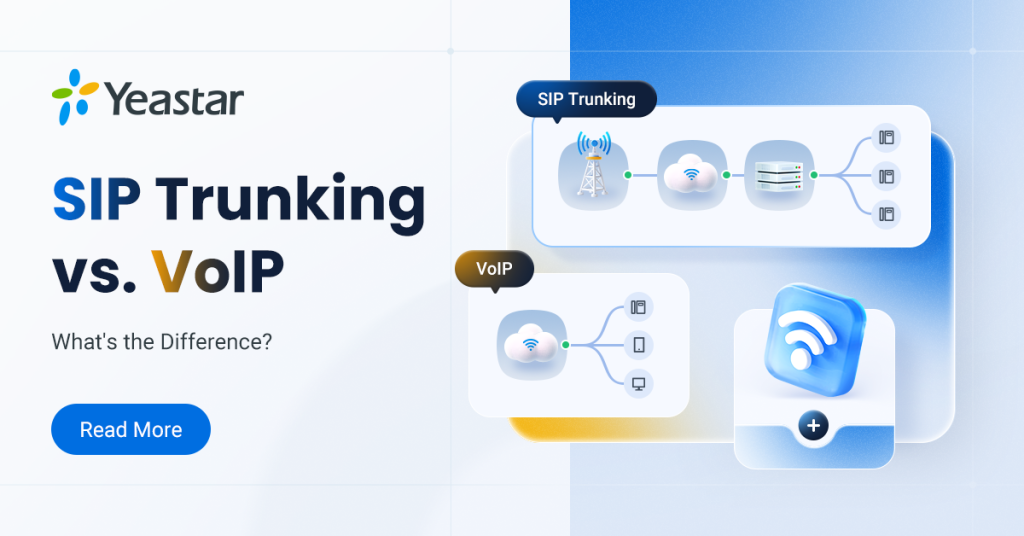SIP Trunking vs VoIP: Differences, Benefits, and Choosing the Right Communication Solution

Introduction: Why SIP Trunking and VoIP Matter
As businesses increasingly transition to digital communication systems, terms like SIP trunking and VoIP often arise in conversations. While these two concepts are related, they serve different purposes in modern telephony and are far from interchangeable. Understanding the distinction between SIP trunking and VoIP is crucial for organizations eager to streamline communications, cut costs, and boost operational efficiency.
What is VoIP?
VoIP, or Voice over Internet Protocol, is a technology that allows users to make voice calls over the internet instead of traditional copper-based phone lines. Essentially, VoIP transforms voice signals into data packets, which are transmitted over IP networks. At the receiving end, these packets are reassembled back into audio signals. Whether it’s a video call, audio communication, or messaging, VoIP underpins internet-based communication systems.
One of the biggest advantages of VoIP is its flexibility. It eliminates the geographical restrictions tied to conventional phone systems, supports seamless conferencing, and integrates with modern platforms like CRM tools. The result? Enhanced communication capabilities at a fraction of the cost of traditional landline networks.
What is SIP Trunking?
SIP trunking (Session Initiation Protocol Trunking) takes VoIP a step further by providing the bridge between a Private Branch Exchange (PBX) telephone system and the Public Switched Telephone Network (PSTN). Through SIP trunks, businesses can connect their IP-based phone systems to external landline and mobile networks. This enables outbound and inbound calls to traditional network systems without requiring costly legacy phone setups.
Think of SIP trunking as the protocol that makes external communication possible for VoIP systems. Without it, businesses could only handle internal VoIP calls within their network. By implementing SIP trunks, companies can centralize communication, leverage international calling at reduced rates, and integrate advanced features like multi-site connectivity and custom call routing.
SIP Trunking vs. VoIP: Key Differences and Benefits
To better understand how SIP trunking and VoIP differ, it’s helpful to view them as components of a complementary system rather than competing technologies. VoIP is the foundation for delivering voice data over internet networks, while SIP trunking is a specific protocol used for connecting those VoIP systems to the external PSTN.
- Flexibility and Scalability: VoIP systems are highly flexible, supporting video, voice, and messaging capabilities. Meanwhile, SIP trunking adds scalability by allowing businesses to easily increase the number of trunk lines as their needs grow.
- Hosted VoIP vs. On-Premises PBX: Small to medium-sized businesses without on-premises infrastructure can benefit from hosted VoIP solutions, which require minimal technical expertise. Enterprises with existing PBX systems can use SIP trunking to extend the life of their technology while upgrading to modern communication features.
Which Option is Right for Your Business?
Choosing between SIP trunking, VoIP, or a combination of both depends on your business setup and communication goals. For organizations with an established PBX system, SIP trunking delivers advanced functionalities such as global connectivity and CRM integration. Businesses without a PBX can start with hosted VoIP solutions, which offer an easy-to-implement, cost-effective alternative.
For companies with high call volumes, SIP trunking provides unmatched scalability, allowing teams to manage growing communication needs with ease. However, for businesses seeking simplified operations, hosted VoIP plans eliminate the need for hardware management, as all administration tasks are handled by the service provider.
Ultimately, the choice boils down to operational requirements, budget, and scalability needs. VoIP alone might work for smaller organizations or those prioritizing simple communication. Conversely, SIP trunking enables extensive network connectivity, making it indispensable for companies requiring robust, multi-site phone systems.
Conclusion: The Power of Combining SIP Trunking and VoIP
Modern business communications don’t need to be one-size-fits-all. Leveraging both SIP trunking and VoIP can give companies the best of both worlds—scalable, cost-efficient communication that integrates advanced features like video conferencing, call routing, and team messaging into one system. Providers like Yeastar offer solutions optimized for both VoIP and SIP trunking, ensuring flexibility and compatibility with over 150 ITSPs globally.
Whether you’re expanding internationally, enhancing collaboration, or modernizing outdated systems, understanding SIP trunking vs. VoIP is essential. Adopt the right strategy and lay the groundwork for future-proof communication.



